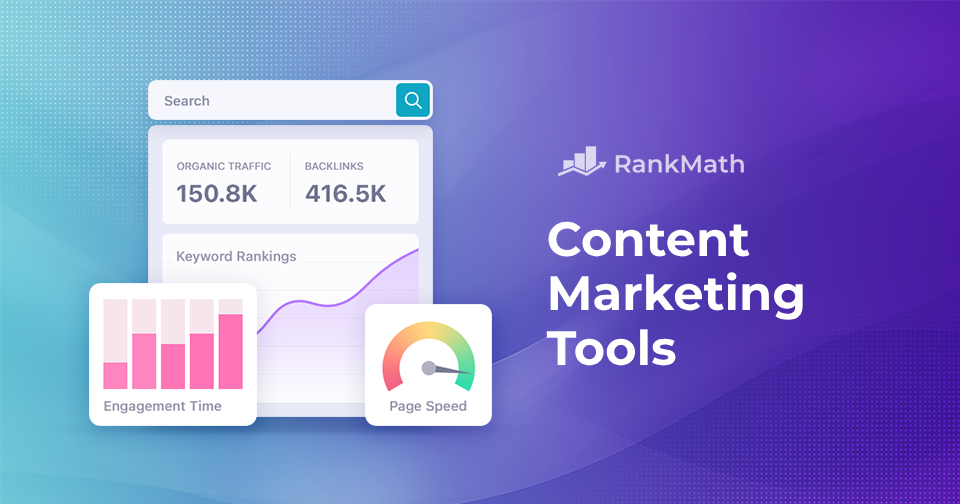We all have heard that content is the king. However, creating, distributing, and analyzing content without the right tools can be challenging.
Content marketing tools transform complex processes into manageable and efficient workflows.
From researching trending topics to optimizing content for search engines, these content marketing tools are essential for you to enhance your strategies and achieve better results.
In this post, we’ll discuss the best content marketing tools to boost your marketing efforts. So, without any further ado, let’s get started.

Table Of Contents
- Google Keyword Planner
- RankBot & Topic Research
- HubSpot’s Blog Ideas Generator
- AnswerThePublic
- Blog Post Wizard
- Grammarly
- Photopea
- Canva
- Piktochart
- Buffer
- Opus Clip
- Google Search Console
- Google Analytics
1 Google Keyword Planner
Google Keyword Planner is a powerful content marketing tool that helps you discover the right keywords to target in your content.
To use the tool, you need a Google Ads account. You don’t have to run any paid ads — just create the account.
Go to ads.google.com. Sign in with your Google account and follow the steps to set up a Google Ads account.
Once inside the dashboard, click on the Tools & Settings icon (a wrench in the top-right corner). Under the Planning column, select Keyword Planner.
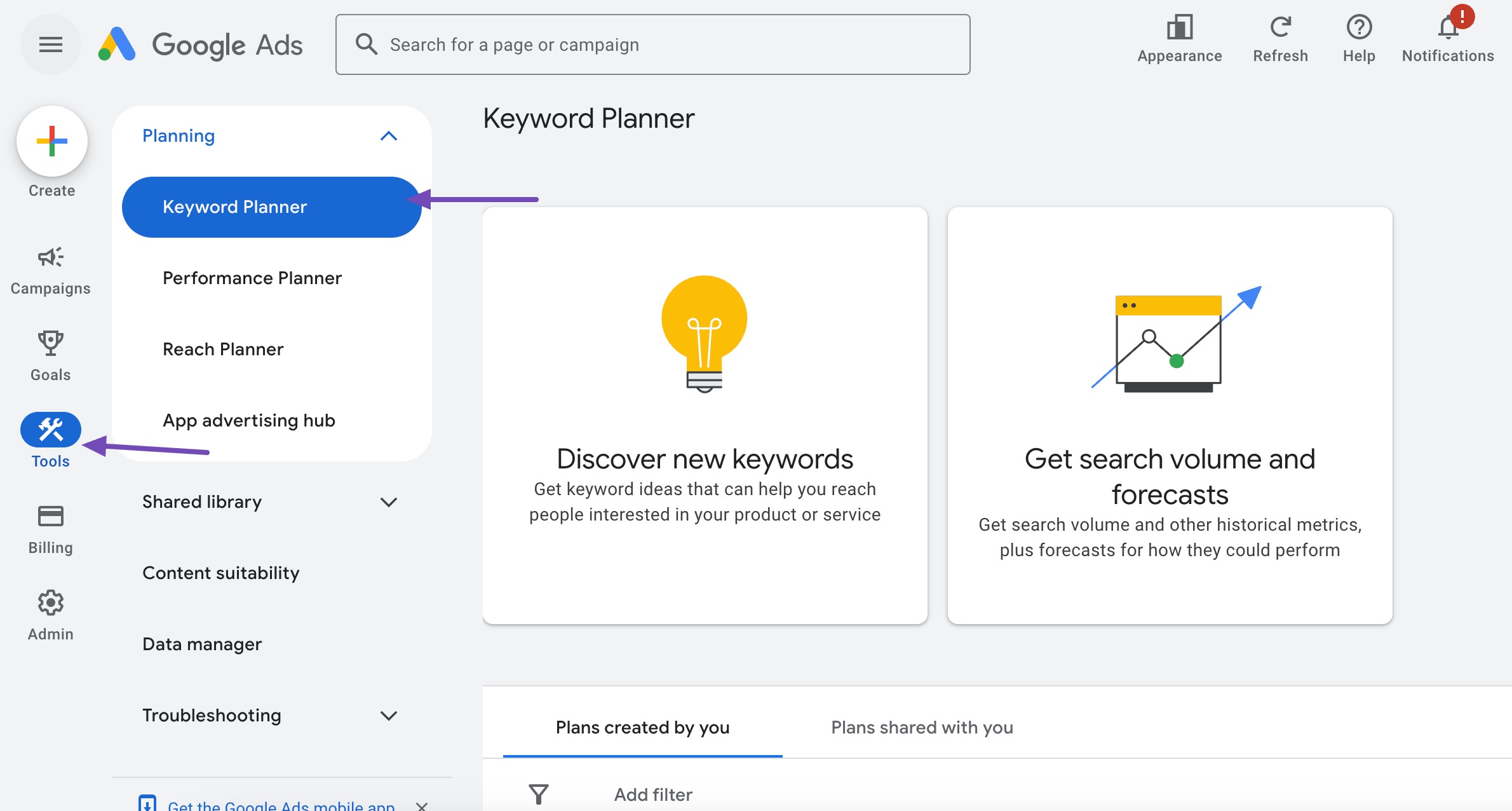
Google Keyword Planner offers two main tools:
- Discover new keywords: Helps you find keyword ideas based on a word, phrase, or URL.
- Get search volume and forecasts: Shows metrics like monthly searches, competition, and CPC for specific keywords.
You can choose to start with Discover new keywords. Enter one or more keywords related to your topic. For example, if you’re planning content about healthy eating, you can enter: healthy snacks for weight loss.
You can also enter a website URL (even your competitor’s) to get keyword ideas based on the content on that site. Click Get Results.
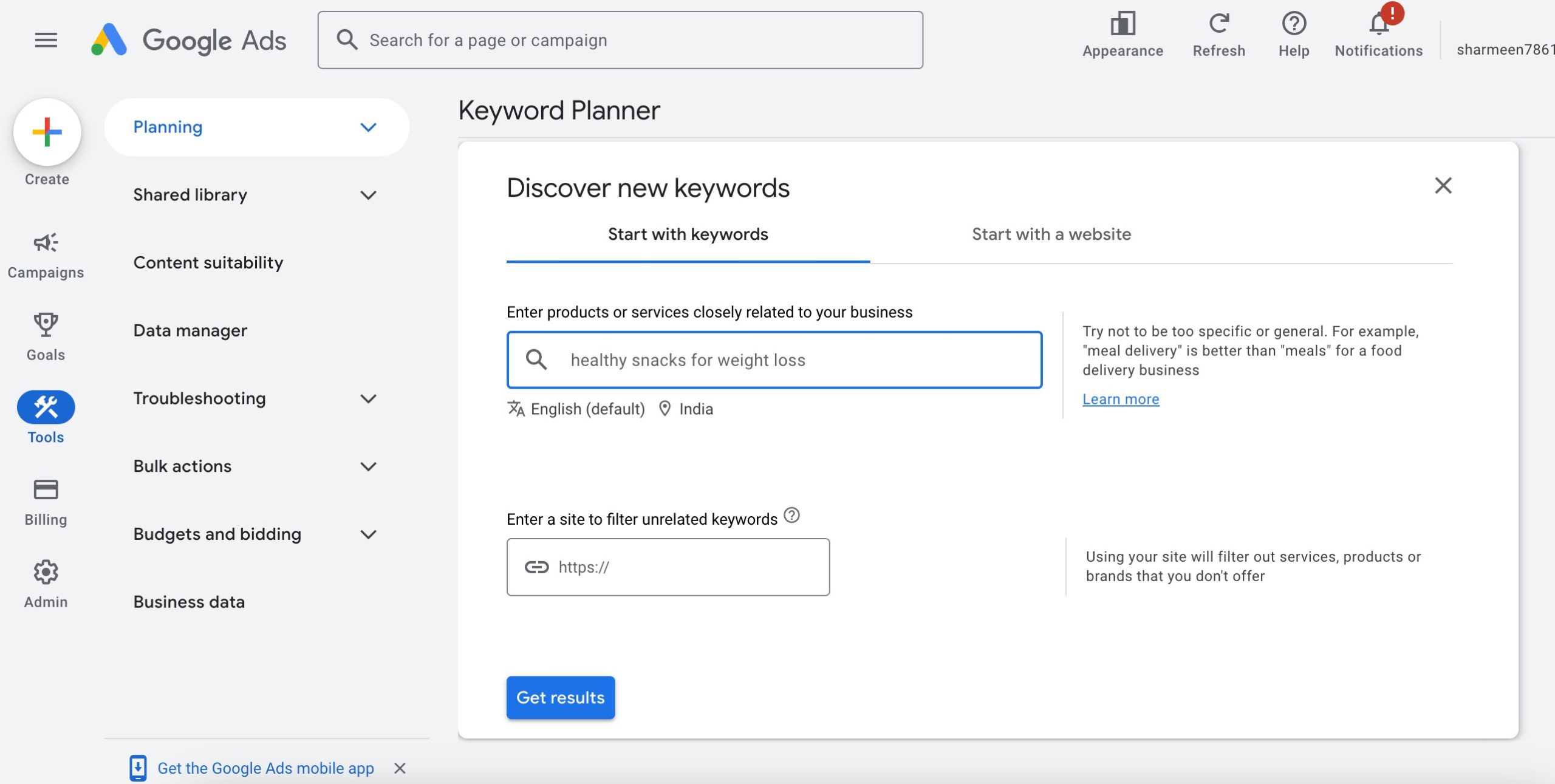
Google will show you a list of keyword ideas along with valuable data, including:
- Average monthly searches: Indicates search demand.
- Competition level: High, Medium, or Low — reflects how competitive the keyword is for advertisers (can also suggest how hard it might be to rank).
- Top of page bid (low/high range): Shows how much advertisers are willing to pay per click. A higher CPC often means the keyword is commercially valuable.
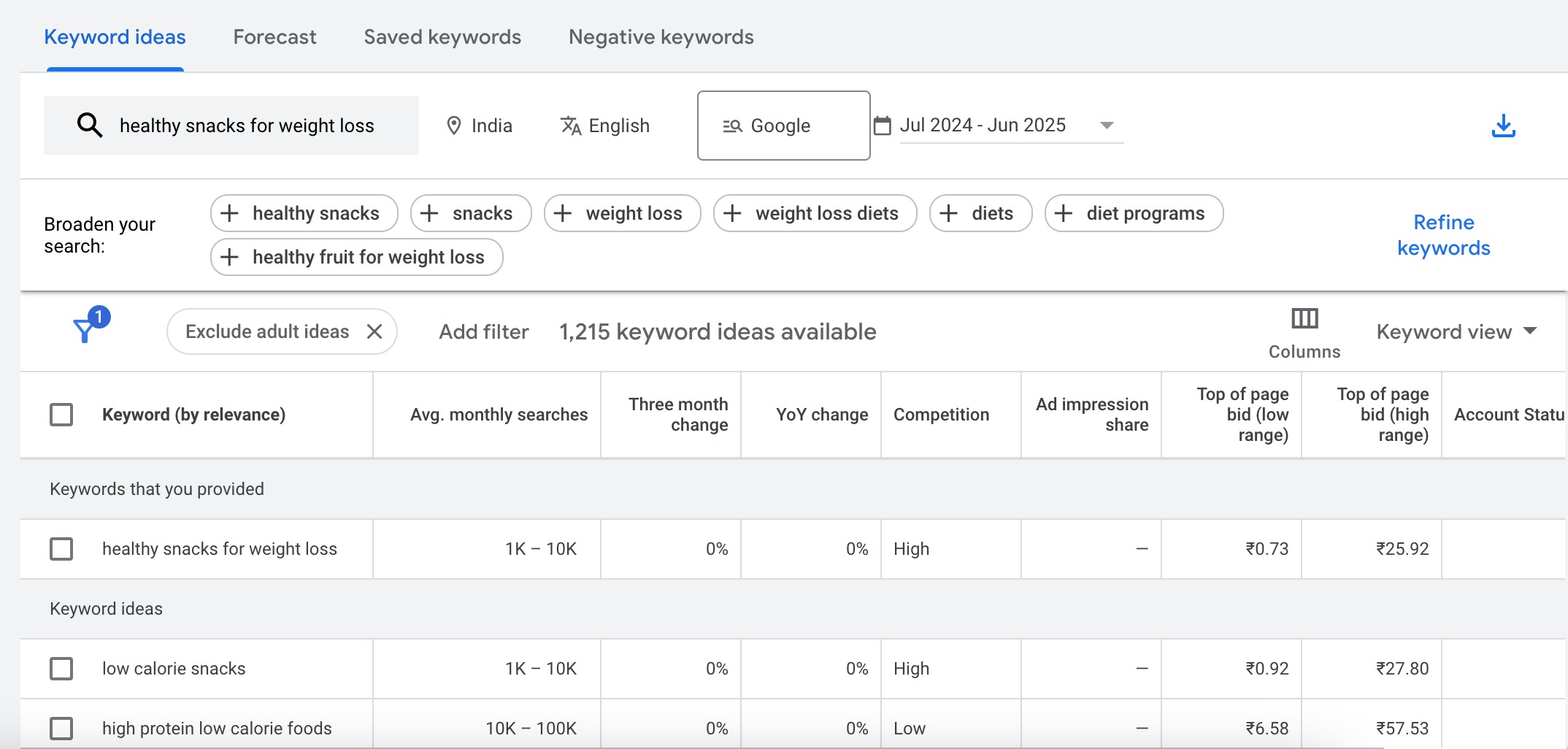
You can also use filters to narrow down results — for example, you can filter by location, language, or exclude branded terms.
Now, choose keywords based on a mix of these criteria:
- High search volume (indicates demand)
- Low to medium competition (easier to rank for)
- Relevant to your content goals
Don’t just focus on one keyword. Choose a primary keyword and then a few related long-tail keywords to support the content. Use your selected keywords strategically in your content.
2 RankBot & Topic Research
Whether you’re using the free or Pro version of Rank Math, once your website is connected to a Rank Math account, you’ll automatically receive 750 free AI credits every month. These credits power the AI tools available in the Content AI module, where one AI credit equals one generated word.
More creators are now using AI to come up with new content ideas and to save time. In fact, 44% say it helps them generate more creative ideas, while 34% use it to reduce the time spent on planning. With Rank Math’s AI features like RankBot and Topic Research, you can do the same.
Use RankBot to Find Keyword Ideas
Navigate to Rank Math SEO → Content AI → Chat from your WordPress dashboard. Ensure you’ve enabled the Content AI module.
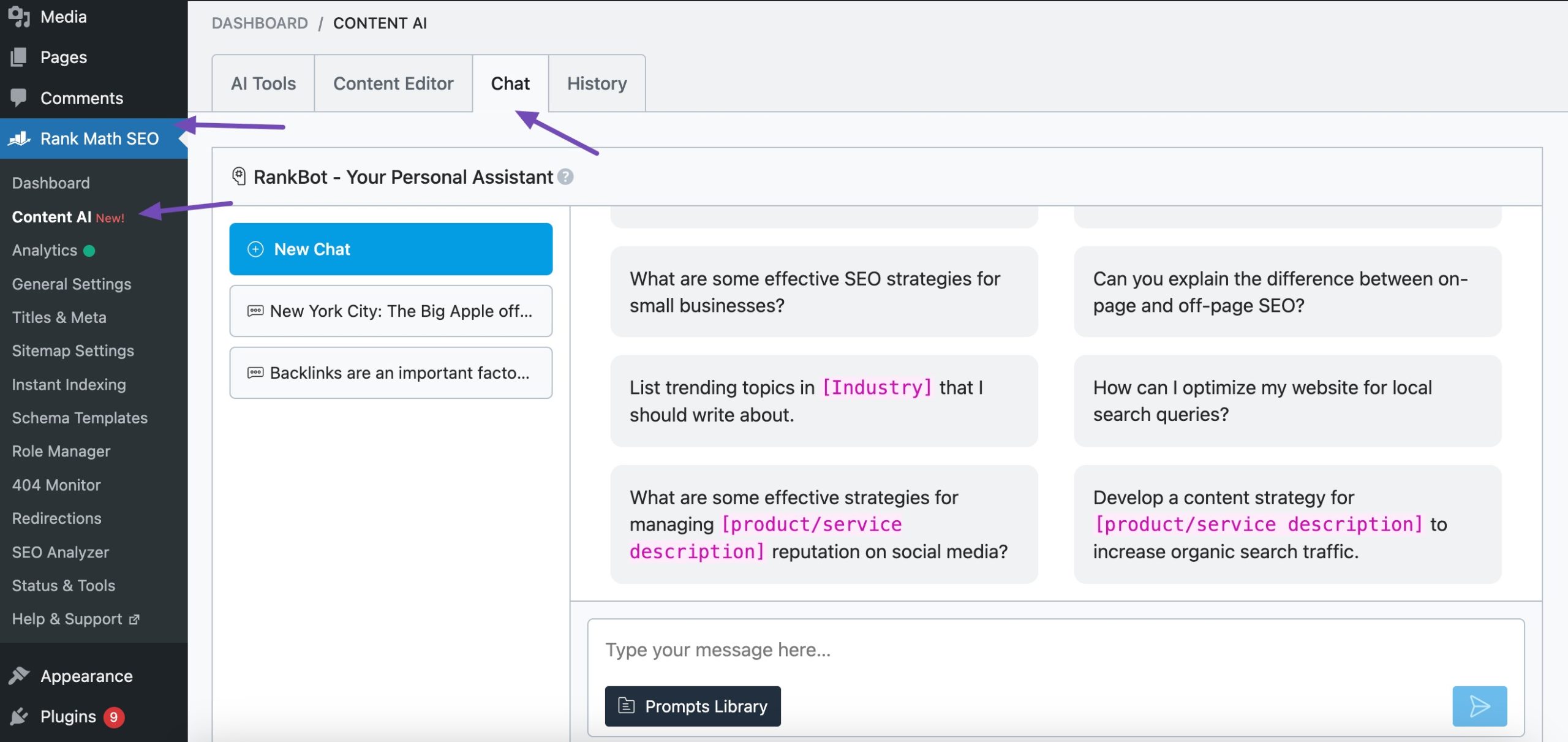
From here, you can interact with RankBot, an AI assistant trained specifically for SEO tasks. For example, you can type:
Generate a list of keywords in the wedding photography niche.
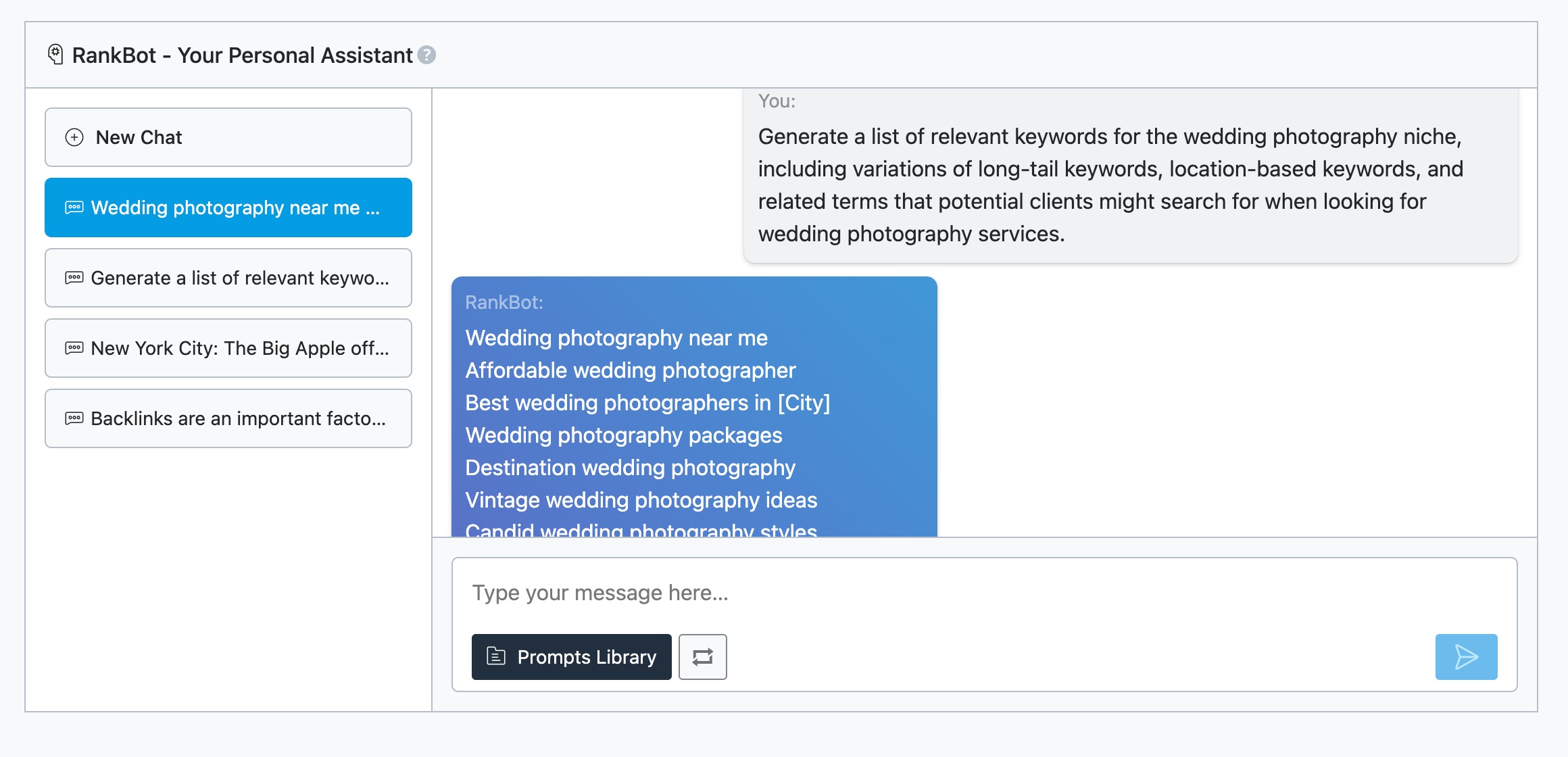
Within seconds, you’ll receive a list of keyword suggestions that can serve as inspiration for future blog posts or landing pages.
However, before moving forward with content creation, it’s important to validate the search volume of these keywords. This ensures you’re targeting terms people are actually searching for—saving time and effort.
Here’s how to verify keyword demand:
- Copy the keyword list.
- Open Google Keyword Planner.
- Select the Get Search Volume and Forecasts option.
- Paste the keywords, clean up any unnecessary words, and click Get Started.
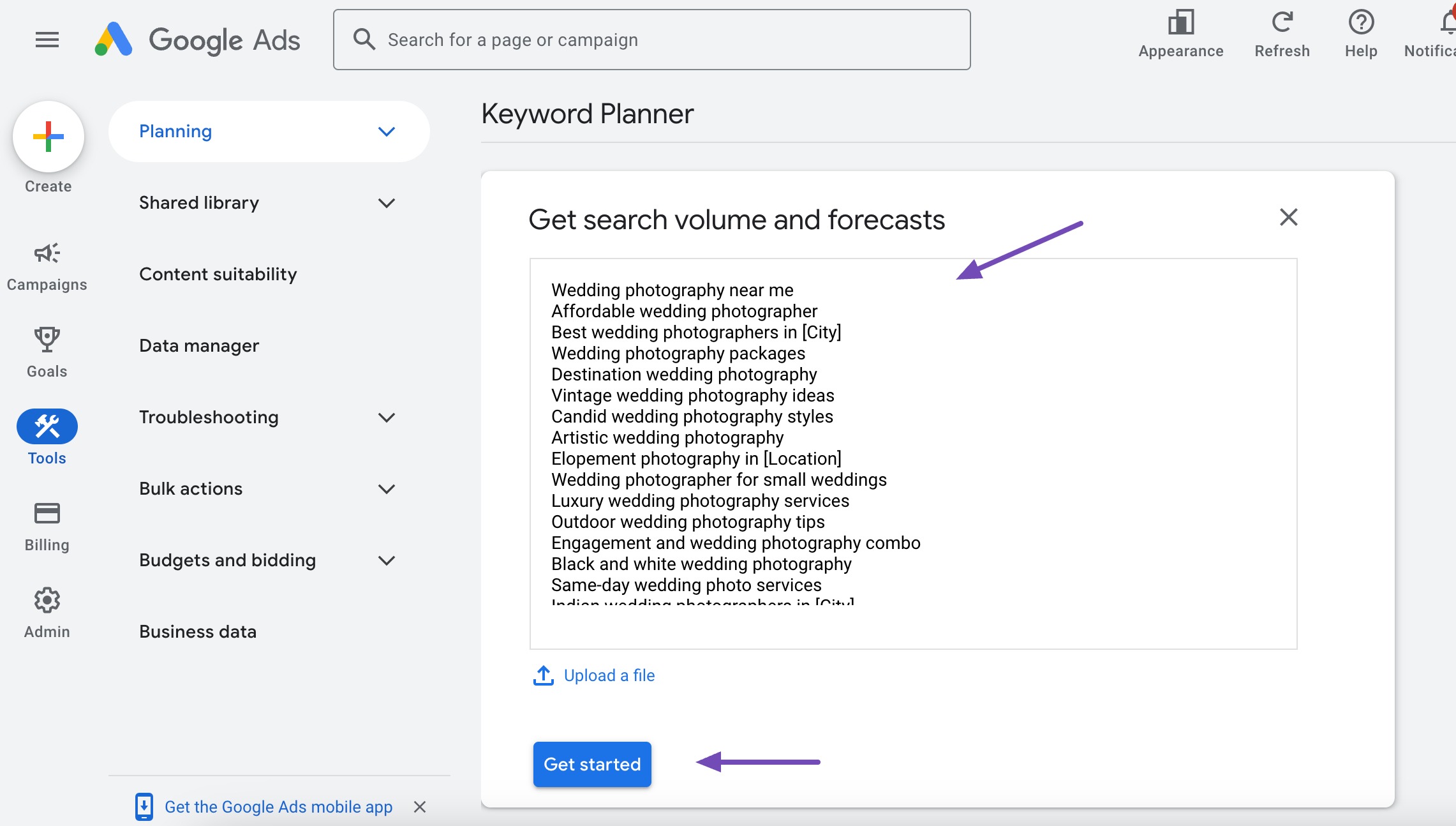
You’ll now see which keywords have significant search volume and which ones don’t, helping you focus only on those worth pursuing.
Use Topic Research to Learn More
Once you’ve narrowed down your list, take the next step by digging deeper using Rank Math’s Topic Research tool.

Next, navigate to Rank Math SEO → Content AI → Content Editor option. Select the Topic Research AI tool, as shown below.

Paste your chosen keyword into the topic field, then decide what kind of information you’d like to see—this can include recent updates, historical context, regional insights, or other specific details. Next, choose how you’d like the results to be displayed, such as in a list format for easier reading.
You can also add a focus keyword if needed and select your target audience. If your audience isn’t listed, you can simply type in a custom one and press the comma or tab to save it. After that, select your preferred language, set the number of results you want, and click Generate.
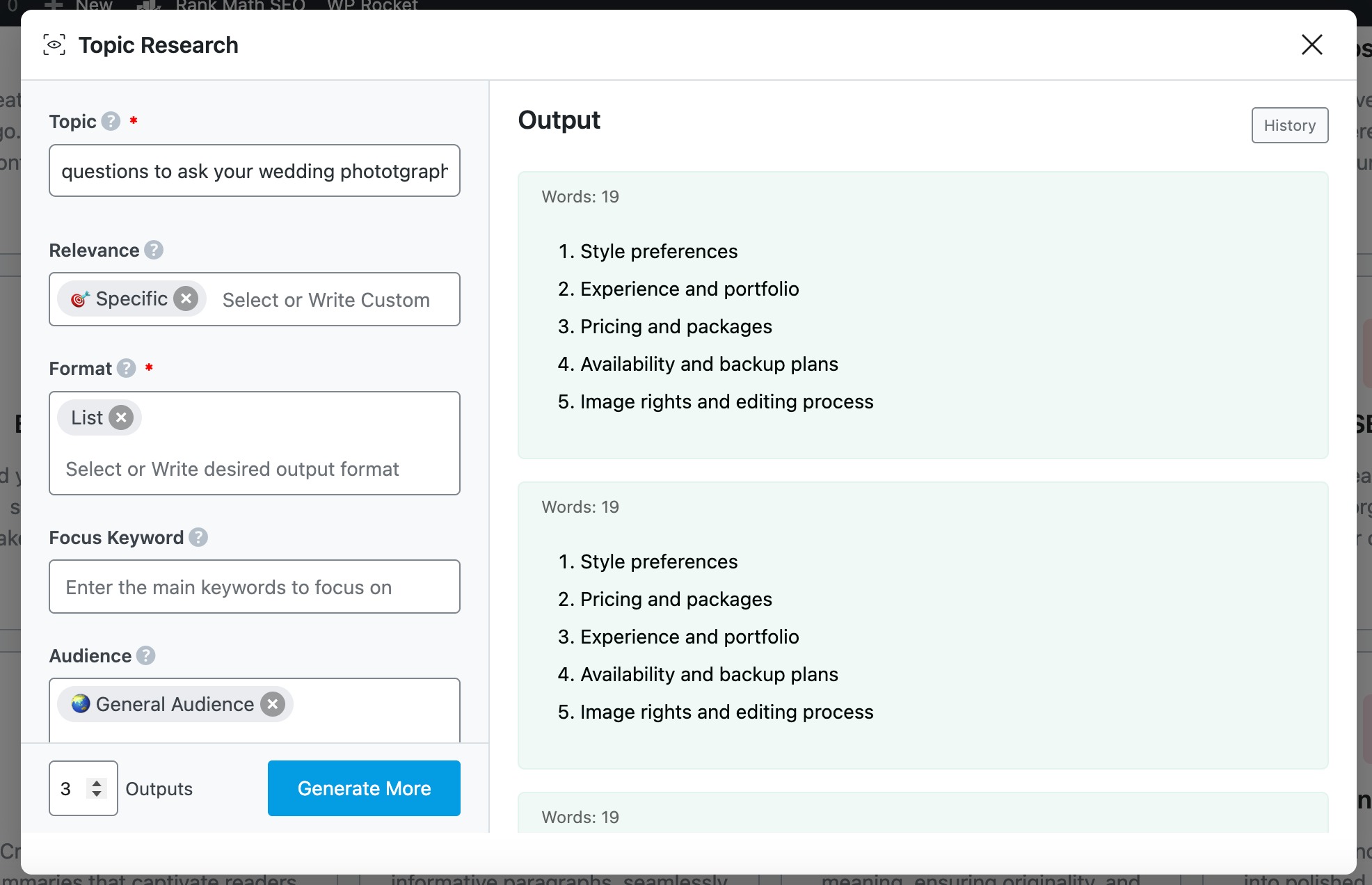
The tool will then provide a structured overview of the keyword, helping you understand what topics to include and how to approach your content more effectively.
3 HubSpot’s Blog Ideas Generator
HubSpot’s Blog Ideas Generator is a free content marketing tool designed to help you come up with blog post titles and ideas when you’re stuck or short on inspiration.
You’ll need to create a free account, and once you’re logged in, you’ll see a dashboard where you can click Generate Ideas.
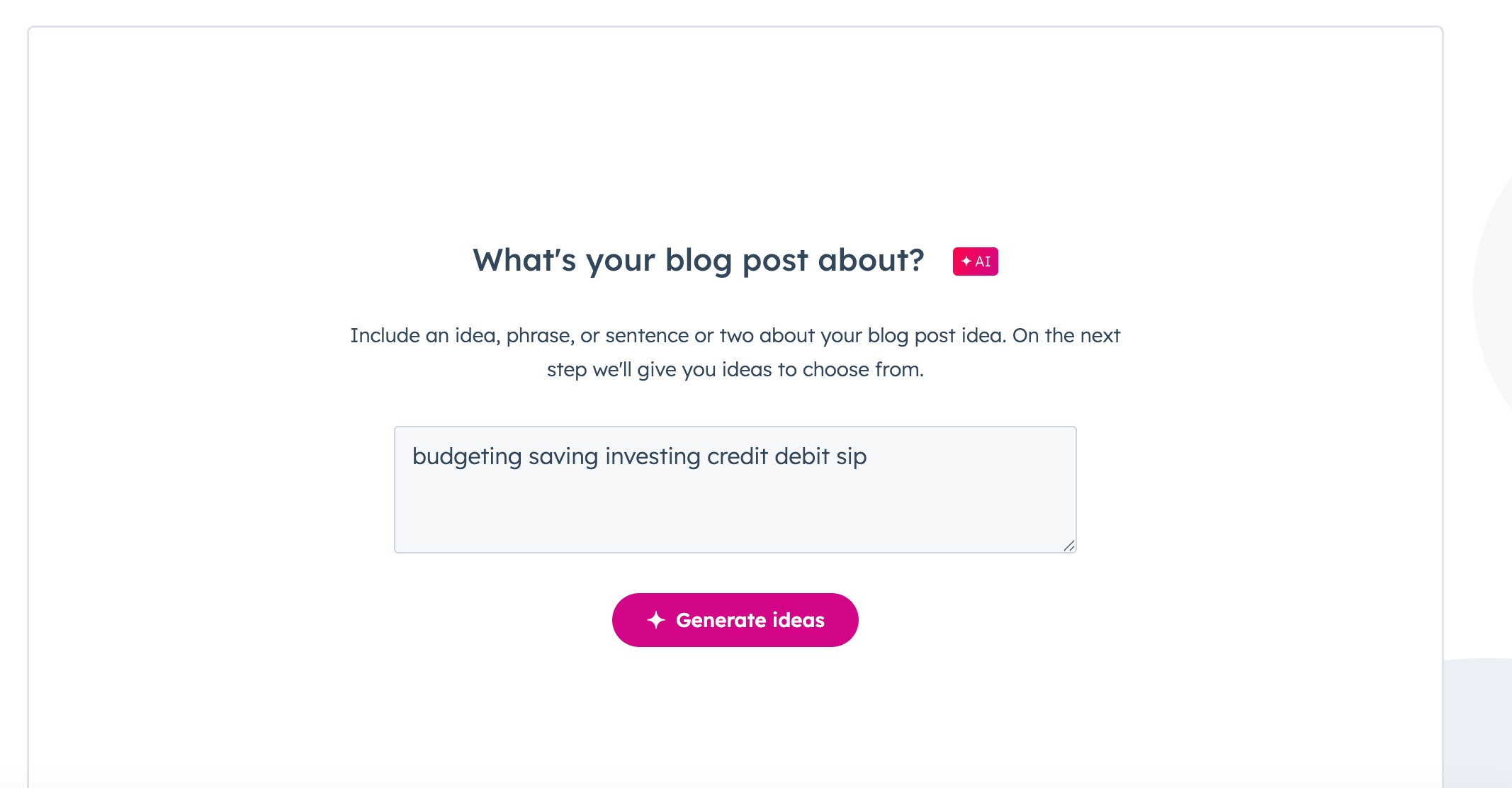
The tool will then give you a list of keywords related to your topic. If you want more suggestions, you can always go back, adjust your prompt, or try a more specific niche or subject to refine the results.
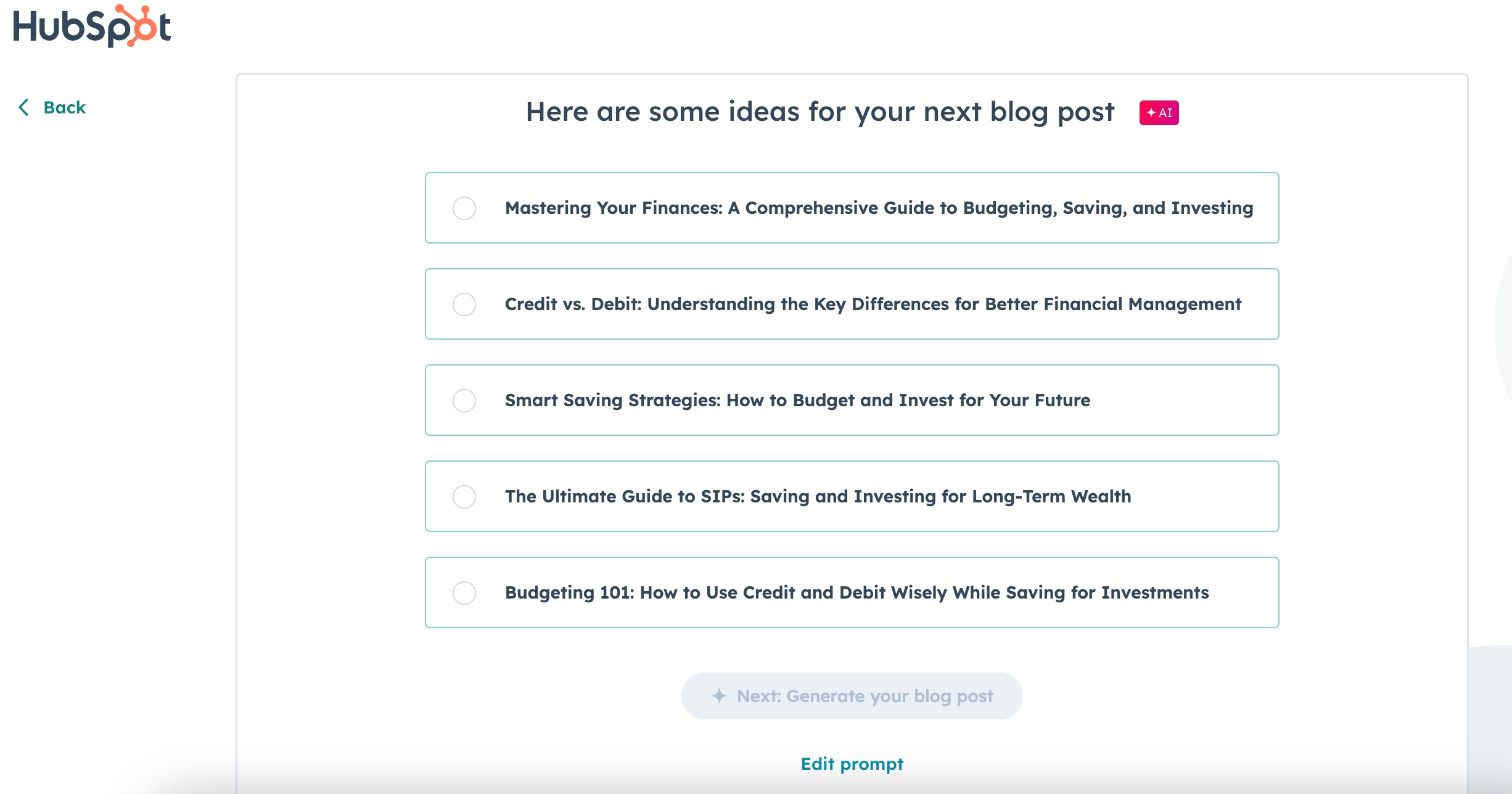
4 AnswerThePublic
AnswerThePublic is a well-known content marketing tool that generates keyword ideas and helps users understand what people are searching for online.
To get started, we recommend creating a free account, which gives you access to three free searches per day.
Once you’re logged in, enter your niche or a related topic. Then, choose your target country. Note that the tool doesn’t currently offer an “All Locations” option, so you’ll need to select a specific country.

After you hit Search, the tool will generate a wide range of keyword suggestions. These are organized into categories such as:
- Questions (e.g., “How to start wedding photography?”)
- Prepositions (e.g., “wedding photography for beginners”)
- Comparisons (e.g., “wedding photography vs. videography”)
- Alphabetical listings, and more.
You can view these results in various formats, including visual wheels, lists, and tables, depending on what works best for your workflow.
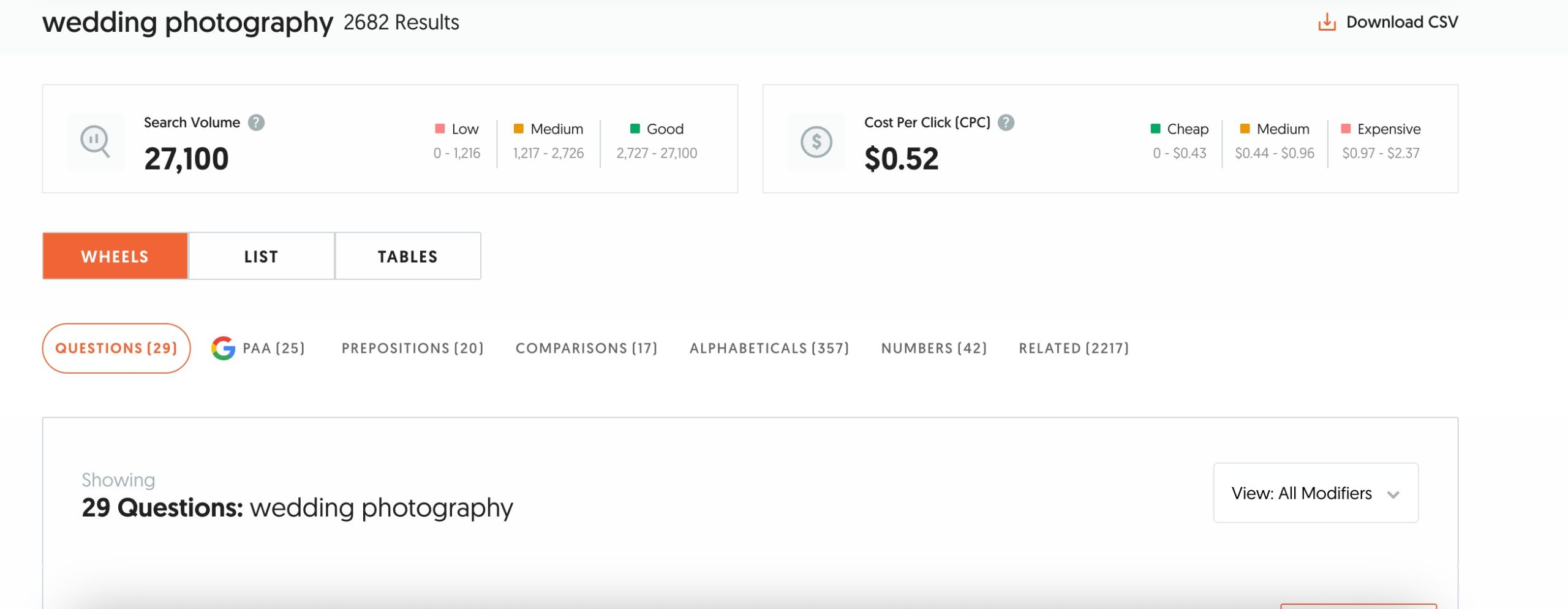
One of the standout features of this tool is that it supports keyword research not only for blogs but also for platforms like YouTube, TikTok, Amazon, and Instagram. It’s a versatile tool that’s simple to use.
If you find yourself using it frequently, consider upgrading to a paid plan for unlimited searches and additional features.
5 Blog Post Wizard
The Blog Post Wizard is an AI-powered tool in Rank Math that helps you create articles from scratch with minimal input. To begin, simply enter a few words describing your niche or industry.
Based on that, the tool will suggest a relevant blog post idea. If you already have a topic in mind, you can skip this step and proceed directly to the next phase.

Once a blog post idea is selected or entered, the Blog Post Wizard will automatically generate a structured outline for the article.

After reviewing the outline, you can click the Write Post button to let the AI create the full blog post content.
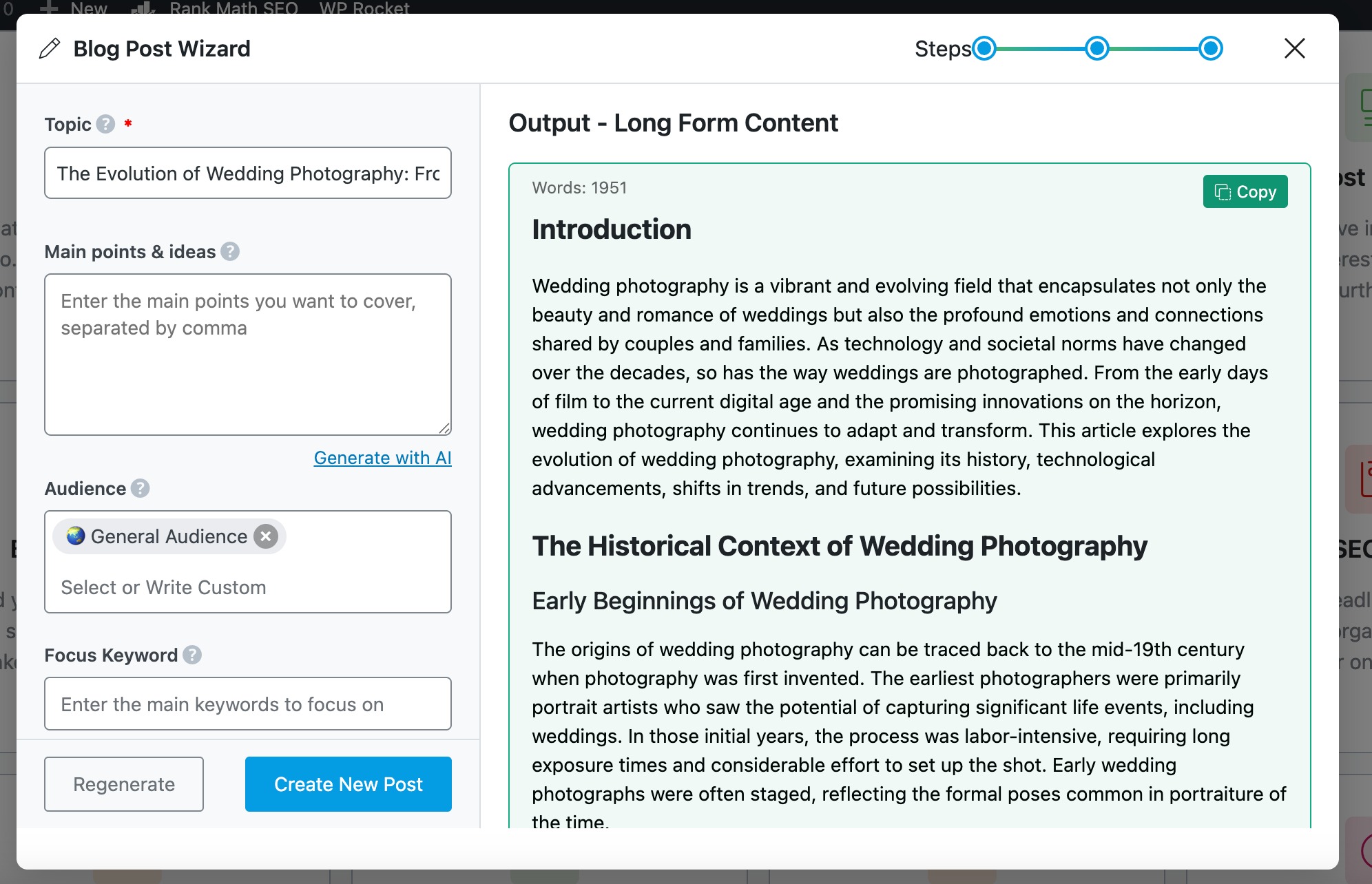
6 Grammarly
Grammarly is widely known as a writing assistant, but it also serves as a powerful content marketing tool.
At its core, Grammarly helps you write better by automatically checking your content for:
- Spelling and grammar errors
- Punctuation mistakes
- Sentence structure issues
- Misused words and typos
Beyond correcting errors, Grammarly also improves the overall quality of your writing by suggesting better word choices, eliminating unnecessary words, and helping you adjust the tone to suit your audience.

While Grammarly isn’t an SEO tool, it contributes to search optimization by improving readability, sentence flow, and overall structure—factors that affect user engagement and time on page.
It also integrates smoothly with tools like Google Docs, Microsoft Word, email platforms, and popular browsers, making it easy to use across different writing environments.
7 Photopea
Photopea is a free, web-based image editor that works directly in your browser.
It’s designed to offer many of the same features found in Adobe Photoshop, making it a powerful tool for photo editing, graphic design, and creating web graphics, without the need to install any software.
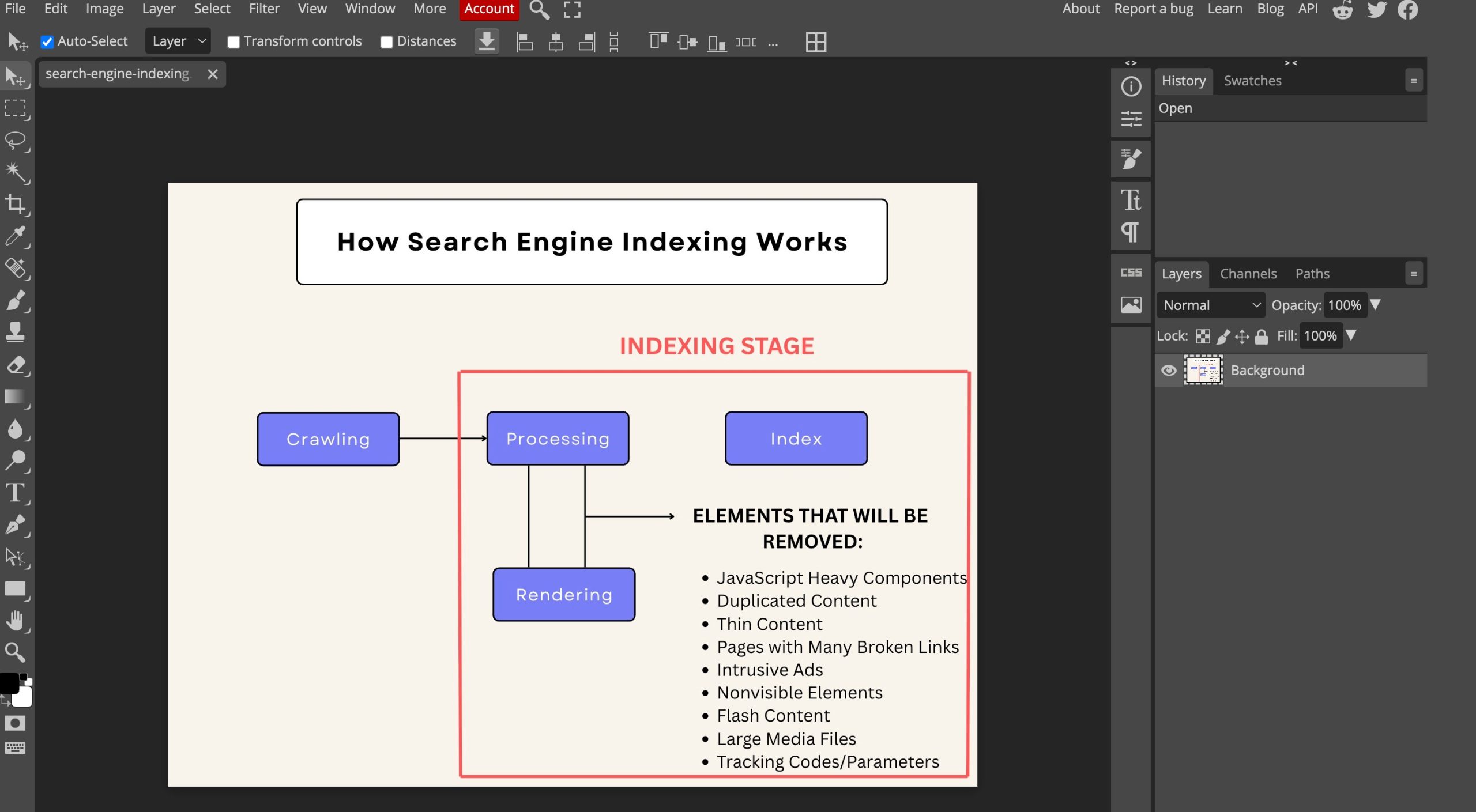
Unlike other online tools that focus only on basic edits, Photopea supports advanced features like layers, layer masks, blend modes, smart objects, and more.
8 Canva
Canva is a user-friendly, web-based graphic design platform that allows anyone to create professional-looking visuals without needing advanced design skills.
Canva uses drag-and-drop functionality, making it simple and fast to design high-quality visuals for both personal and business use.
Canva offers thousands of customizable templates for various formats, including Instagram posts, YouTube thumbnails, flyers, resumes, infographics, newsletters, business cards, and more. You can start from scratch or choose a template to modify.
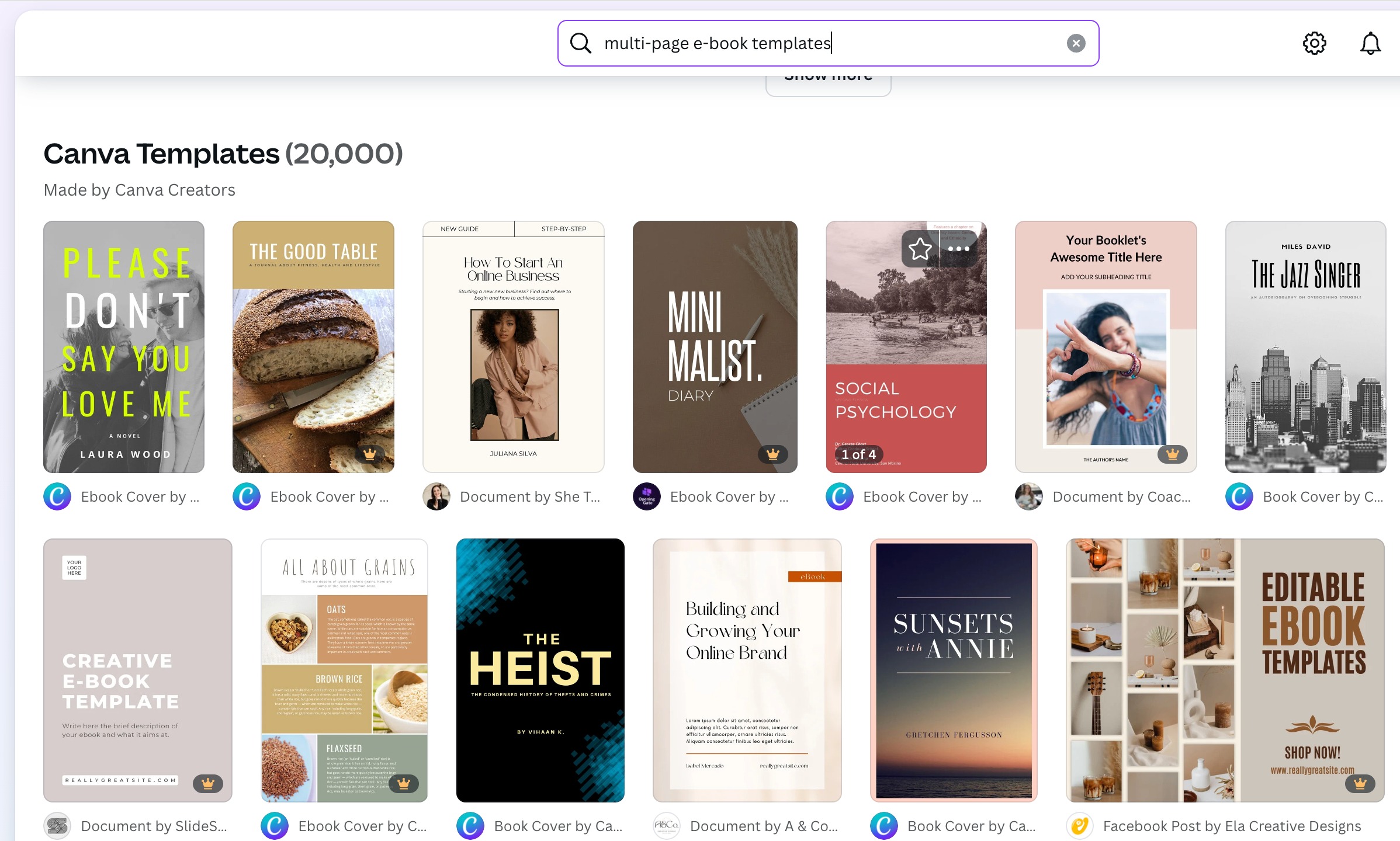
You can share designs with teammates and work on them together in real time—ideal for remote teams and content creators.
9 Piktochart
Creating infographics used to be a time-consuming task, especially if you didn’t have design skills. In many cases, you’d need to hire a graphic designer. But with Piktochart, creating professional-looking infographics is much simpler and more accessible, even for beginners.
To get started, choose what type of content you want to create—infographic, social media graphic, presentation, or document. In our case, we’ll go with an infographic.
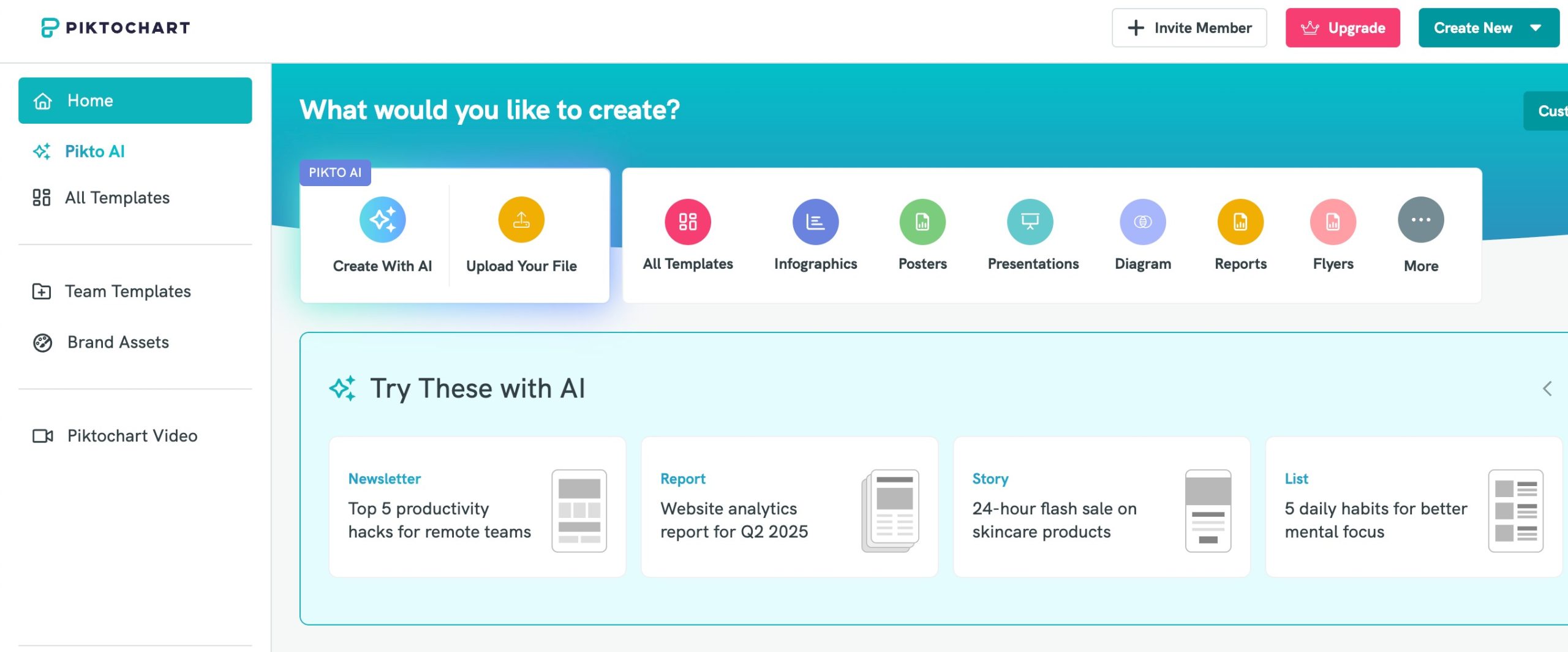
Next, select a style or layout that fits your needs. Let’s say you have a PDF document, and you want to turn it into a visual infographic. Since this involves data, a chart template would be appropriate.
If you’re working with blog content, you can paste your key points directly into the editor.
Piktochart will then suggest designs based on your input. Browse through the available templates and pick one that fits your needs.
From here, you’ll see that the tool has automatically generated charts and visuals based on the data from your PDF.
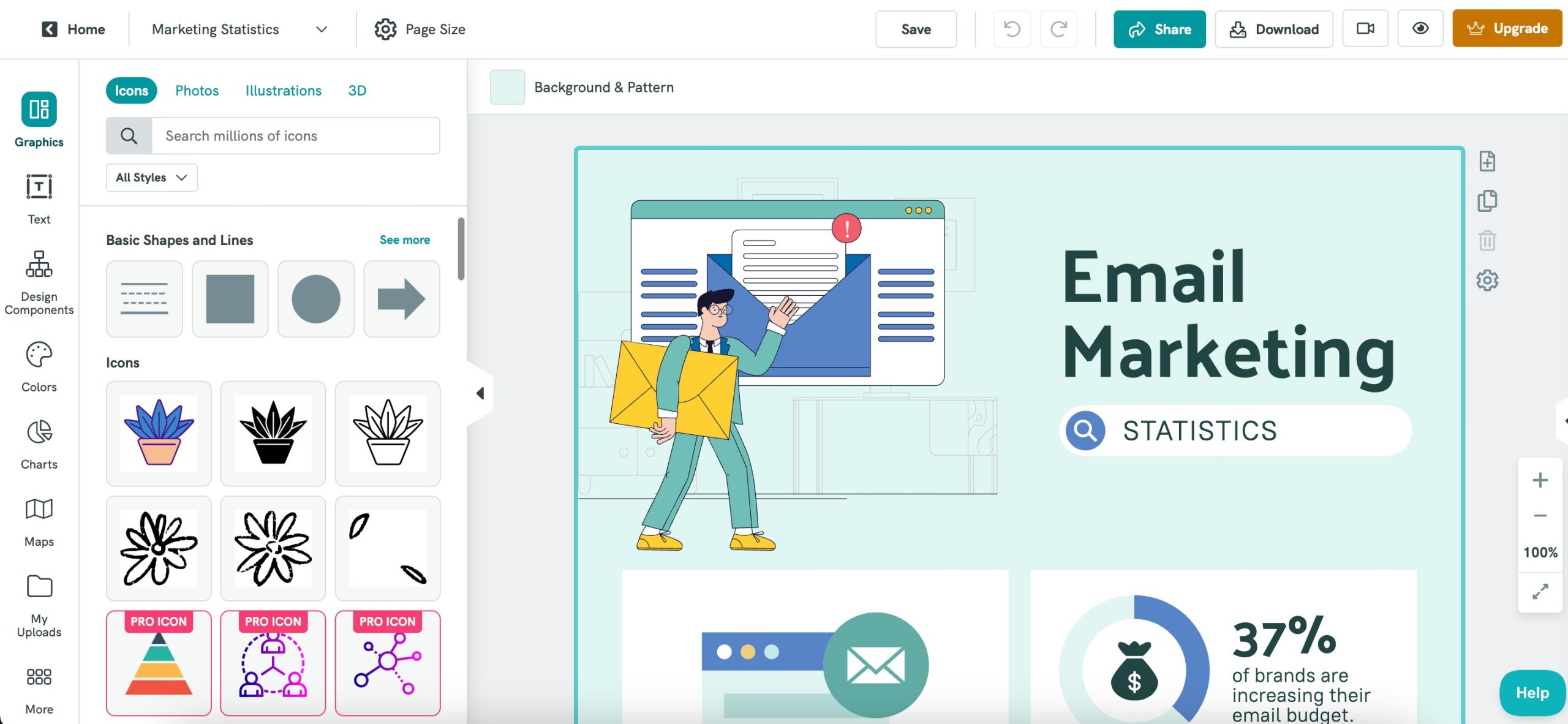
Piktochart is a practical content marketing tool that helps you turn plain information into eye-catching visuals, enabling you to create engaging content for your website without requiring advanced design skills.
10 Buffer
Buffer is a social media management tool that helps individuals, businesses, and marketing teams schedule posts, track performance, and manage multiple social media accounts in one place.
It’s designed to save time, keep your content organized, and make social media marketing more efficient.
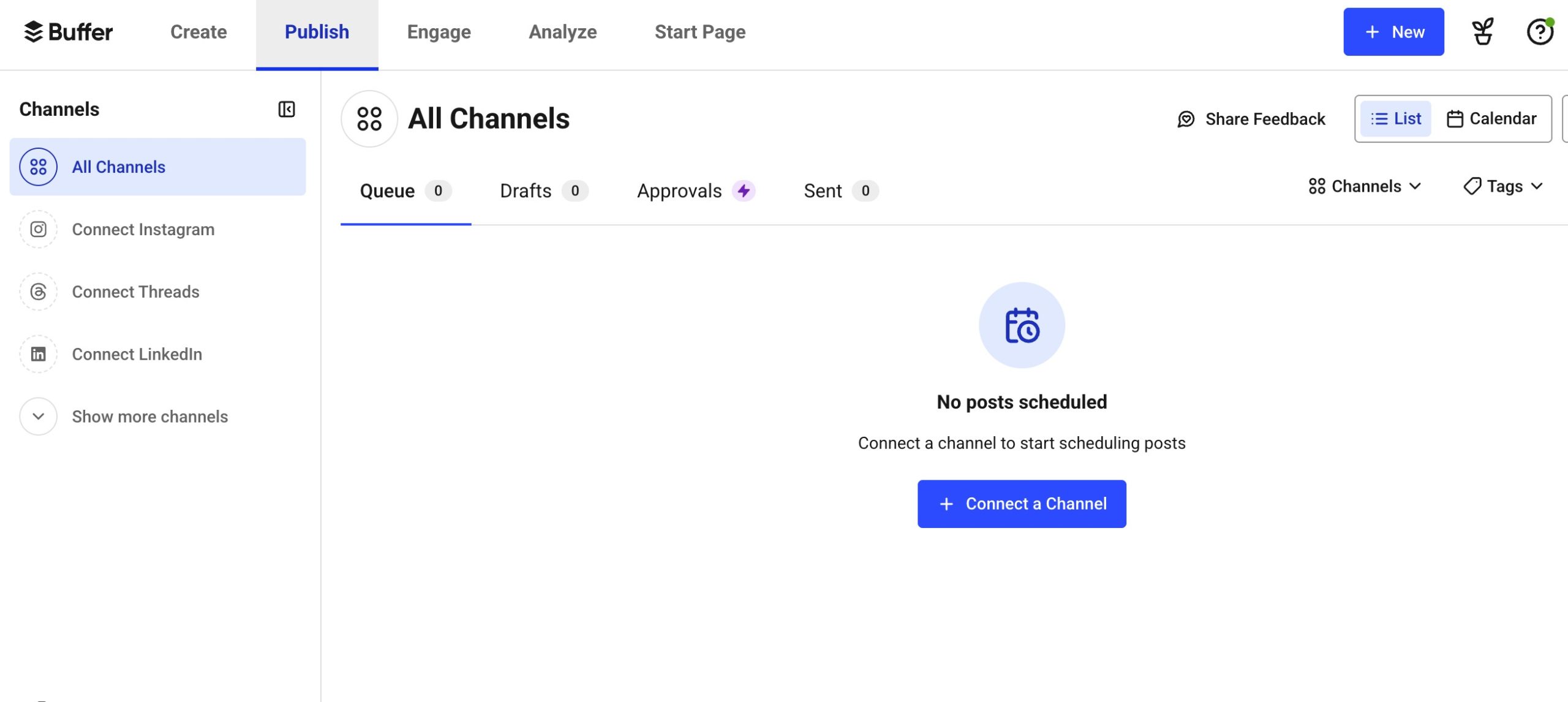
Buffer allows you to schedule posts in advance across platforms like:
- Facebook (pages and groups)
- Twitter (now X)
- LinkedIn (profiles and pages)
- TikTok
You can create and queue posts for days, weeks, or months ahead, ensuring consistent activity without having to post manually every day.
The built-in calendar gives you a visual overview of all your upcoming posts. You can drag and drop to rearrange content, see what’s scheduled across each channel, and fill in content gaps easily.
The free plan allows you to manage 3 social accounts, and 10 scheduled posts per account.
11 Opus Clip
OpusClip is an AI-powered video editing tool that automatically repurposes long-form videos—such as webinars, podcasts, interviews, and YouTube videos—into short, engaging clips optimized for platforms like TikTok, Instagram Reels, YouTube Shorts, and Facebook.
OpusClip uses AI to scan your long-form video and identify the most engaging, high-retention moments. It looks for:
- Highlights or exciting moments
- Quotes or key soundbites
- Emotional expressions or emphasis in speech
Simply add a video link and click Get free clips.

This is especially helpful for creators who want to extract viral moments without manually watching and cutting their videos.
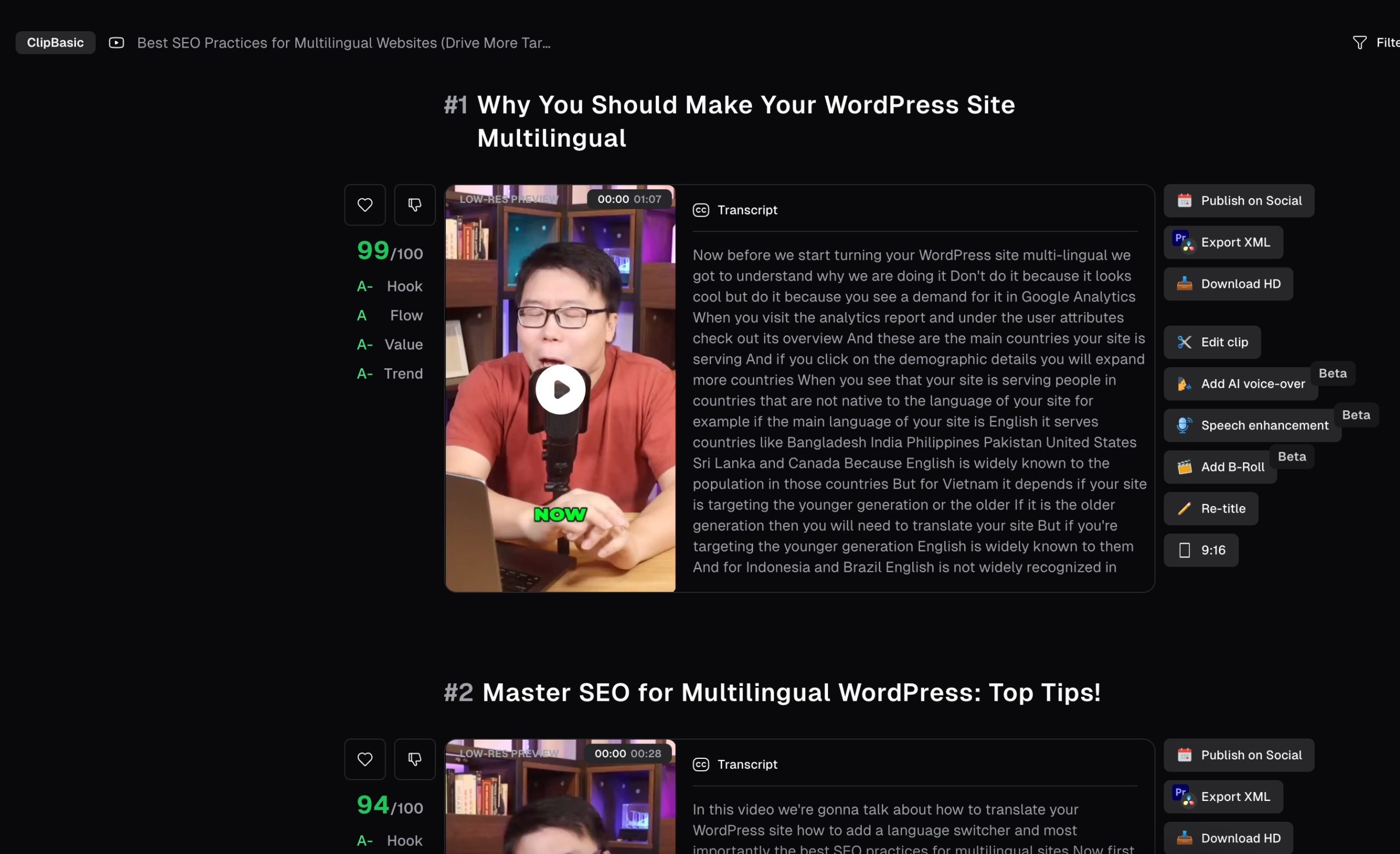
12 Google Search Console
Google Search Console is a content marketing tool that provides valuable insights into how your website performs in Google search results.
This free tool from Google offers detailed analytics about your website’s search traffic, indexing status, and visibility, helping you optimize your content for better search engine rankings.
By using Google Search Console, you can monitor key metrics such as clicks, impressions, click-through rates (CTR), and the average position of your pages in search results.
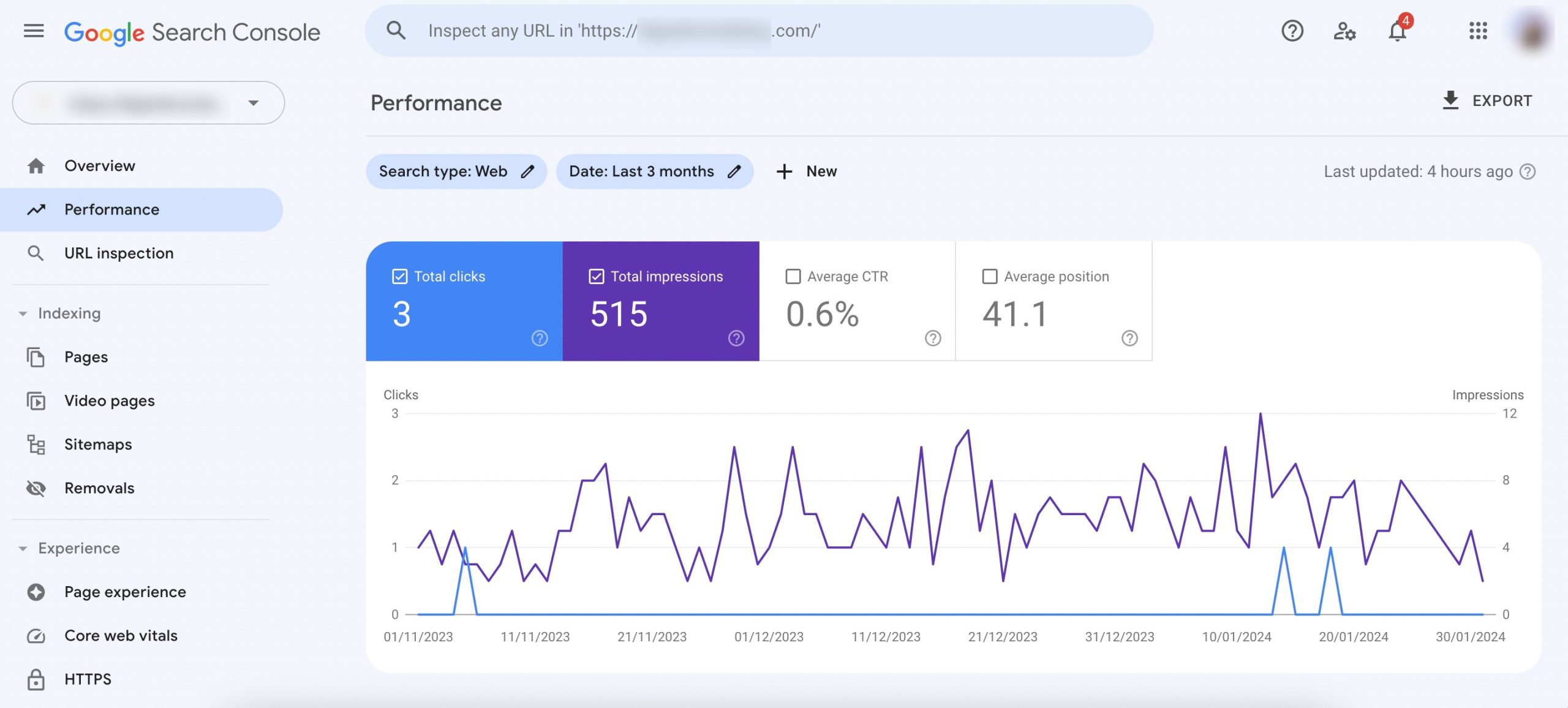
One of the core features of Google Search Console is its ability to identify which queries bring the audience to your site, enabling you to understand what your audience is searching for and create your content accordingly.
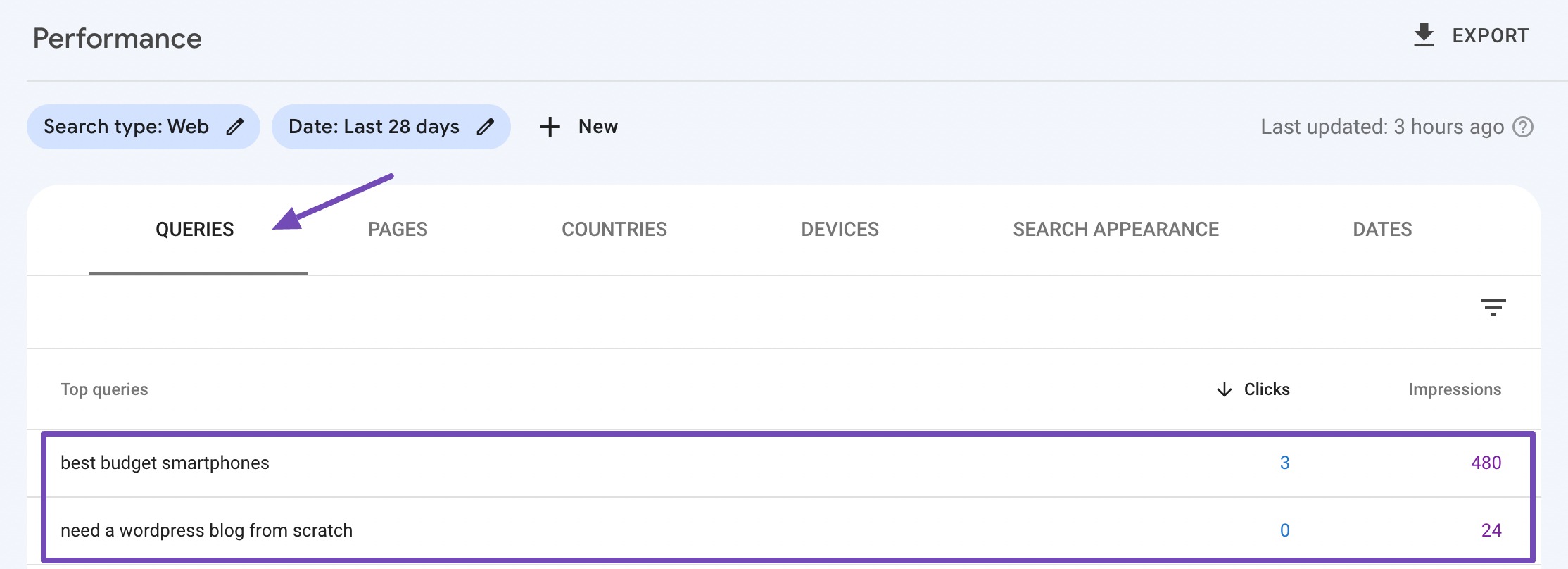
Additionally, it highlights any indexing issues, such as pages that aren’t being properly crawled by Google, allowing you to address these problems and ensure your content is accessible.
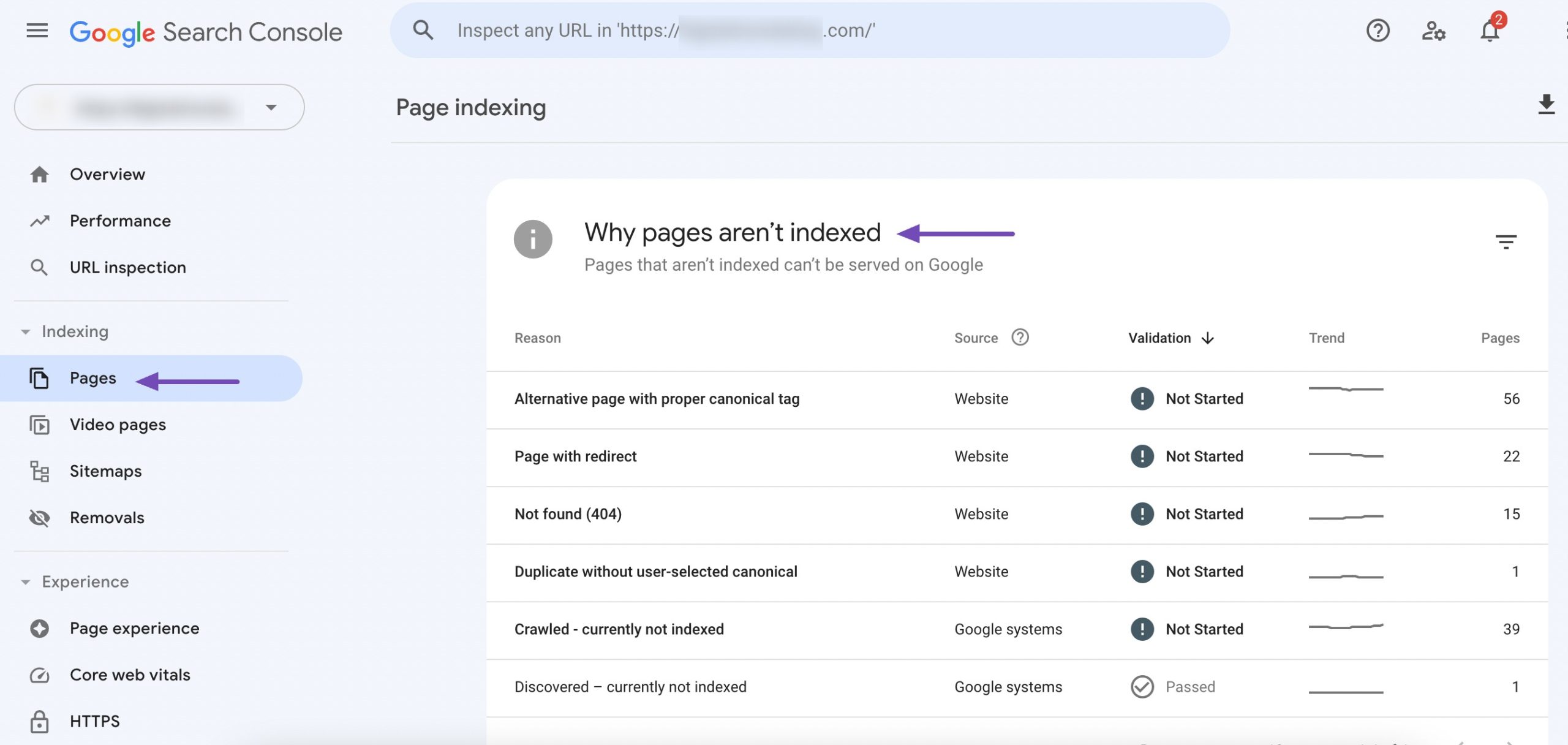
Google Search Console’s performance reports help you track how changes to your content and SEO strategies impact your search traffic over time.
By analyzing this data, you can make informed decisions about which content to update, which keywords to target, and how to refine your overall content marketing strategy to achieve better results.
13 Google Analytics
Google Analytics is an essential free content marketing tool that provides comprehensive insights into how your audience interacts with your website.
Tracking and analyzing various metrics helps you understand audience behaviour, measure content performance, and make data-driven decisions to improve your strategies.
It’s particularly useful for analyzing your content’s performance in terms of engagement and conversions.
You can do this by examining the Pages and screens report. This report shows how long the audience focused on your content and how many conversions each page generated within the selected time range.

By using the detailed insights provided by Google Analytics, you can continuously refine your strategies, enhance the user experience, and ultimately drive more targeted traffic to their websites.
Conclusion
Content marketing tools are essential for enhancing the effectiveness and efficiency of your marketing strategy.
From content research and planning to creation, optimization, and performance analysis, these tools cover every aspect of the content marketing lifecycle.
By continuously monitoring performance and making necessary adjustments, you can ensure your content remains impactful and aligned with business goals.
Investing in the right content marketing tools can significantly boost your strategy, drive more organic traffic, and ultimately lead to higher engagement and conversions.
Which content marketing tools do you use on your site? Let us know by Tweeting @rankmathseo.
